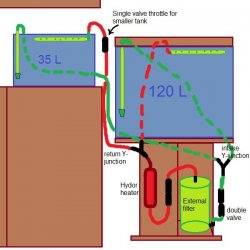I've been wondering if this sort of setup could work (not that I'm thinking of getting two more tanks, oh no  )
)
Two tanks, 35 and 120L
External filter, e.g. Eheim
External Hydor heater
Two Y junctions on the intake and return pipes to run both tanks through one filter
Single valve on return pipe to small tank to throttle flow (if necessary)
Could this work and what are the potential problems of doing it?
Click on diagram to see what I mean

Two tanks, 35 and 120L
External filter, e.g. Eheim
External Hydor heater
Two Y junctions on the intake and return pipes to run both tanks through one filter
Single valve on return pipe to small tank to throttle flow (if necessary)
Could this work and what are the potential problems of doing it?
Click on diagram to see what I mean

